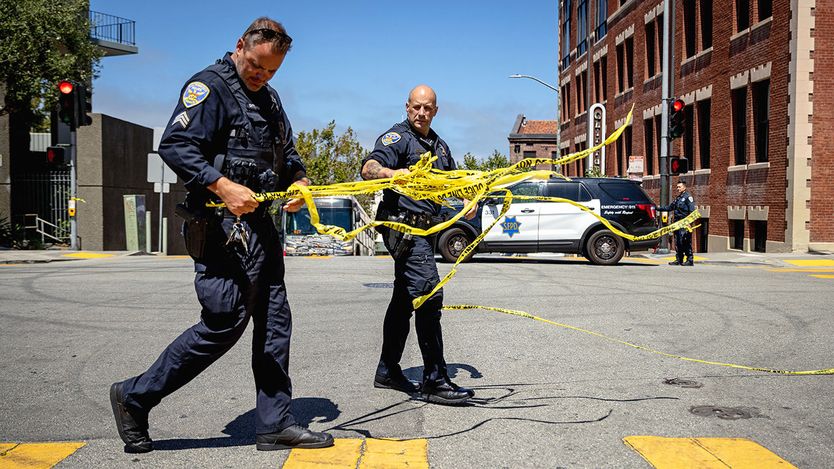Take the subway to Upton, a station on Pennsylvania Avenue in West Baltimore, and when you emerge onto the street, you may think you have arrived in a scene of The Wire, an old hit HBO show. Young men hang around, a few hawking drugs. Speak to Malik, a 40-year-old man selling knock-off Ray-Bans from a bin bag, however, and you will quickly be disabused of the idea that nothing has changed. “Where you are standing, try about ten years ago, you couldn’t hear yourself think,” he says. “It was all guys shouting ‘red top’, ‘red top’, ‘yellow top’, ‘yellow top’.” Now, he says, “it is all cleared out. I don’t know what’s going on. It’s gentrifying I think. Shit looks nicer, know what I mean?”
Baltimore was associated with violence even before The Wire made it famous for it. But something seems to be changing. So far this year there have been just 45 homicides in the city, down by a third from the same period last year. Last year was already Baltimore’s best in over a decade, with 199 homicides. In 2021 the city recorded 344. At the Johns Hopkins Hospital, Katherine Hoops, a paediatric doctor and researcher, says that it hasn’t admitted a child injured by a gun for months. A few years ago it treated at least one a month.

Baltimore’s decline in violence is not unique. Its improvement is especially stark, but in fact crime appears to be falling all over America. Jeff Asher, an analyst who compiles a real-time crime index from agency-level records, reckons that this year is on track to be the least murderous nationwide since the 1960s. Summer could always change that, but at this point, says Mr Asher, the trend looks solid. The mystery is what is behind it.
Academics are still working out why violence surged in 2020. But the most likely reason is that trust in police collapsed just as the pandemic shuttered social services and heightened stress. In the wake of the murder of George Floyd by a police officer in Minneapolis that spring, and the subsequent outpouring of rage at bad policing, demoralised cops quit in droves. But the improvement now is too big to just be a reversion to pre-pandemic trends. Despite hiring programmes, most police departments are still woefully undermanned.
So what is happening? Explanations abound. For example, Ray Kelly, a police-reform activist, says that fentanyl is now so cheap it is not worth standing on a street corner to sell it any more. Car theft has fallen, thanks to immobilisers and wheel locks, which may make other crimes harder to carry out. These reasons may matter, but they understate the value of work done both in Baltimore and nationally since 2020. Under Joe Biden the federal government poured hundreds of millions of dollars into “community-violence interruption” programmes. Police chiefs meanwhile tried—often fitfully—to rebuild trust. Baltimore’s success looks like a particularly striking example of how this may have actually worked.
The city’s own surge in violence came in 2015, after the death of a young black man, Freddie Gray, at the hands of police. In the years after, horrendous police-corruption cases distracted from reform. But now it is under way. According to Richard Worley, the city’s police commissioner, “we are nowhere near the same police department we were five years ago.” He stresses that police are not the only ones to credit. The local model, known as the Group Violence Reduction Strategy, brings together community groups and prosecutors, too.

This model, according to Daniel Webster, an expert on gun violence at Johns Hopkins University, is one of focused deterrence. It is tricky to get right, he says, but Baltimore seems to be managing it. Young men caught up in the criminal-justice system are given a choice: sort yourself out or, ultimately, end up in jail. The carrot is provided by charities: two in Baltimore, Roca and YAP, give therapy and job training to young men referred to them by the police. If the men do not co-operate, cops provide the stick. In recent years arrests have increased somewhat in the city, having plummeted after 2015 (see chart).
Can the improvements continue? Mr Worley says he would like to get the annual number of murders in Baltimore below 100 before he retires. That is ambitious. Unfortunately, the model is now under threat. The new administration in Washington has little time for nuanced approaches to policing. Kurtis Palermo, the head of Roca in Baltimore, says that last month, $1m of its federal funding was cut suddenly. At the same time, federal law enforcement is being redirected towards a new goal: mass deportations. And instead of reform Mr Trump wants to offer pro bono legal help to cops accused of wrongdoing (which might help a bit with morale).
The good news is that lower levels of violence can be self-reinforcing. With fewer murders, detectives have more time to solve each one. With fewer calls, beat cops can do more to build trust. On a ride with police in Baltimore, on a rainy Tuesday afternoon, The Economist saw how lower violence helps officers refocus. Two cops spent half an hour helping one lady resolve an argument with her mobile-phone company. Your correspondent was chastised for using a banned phrase: “it’s quiet.” Long may it remain so.
Source: The Economist


